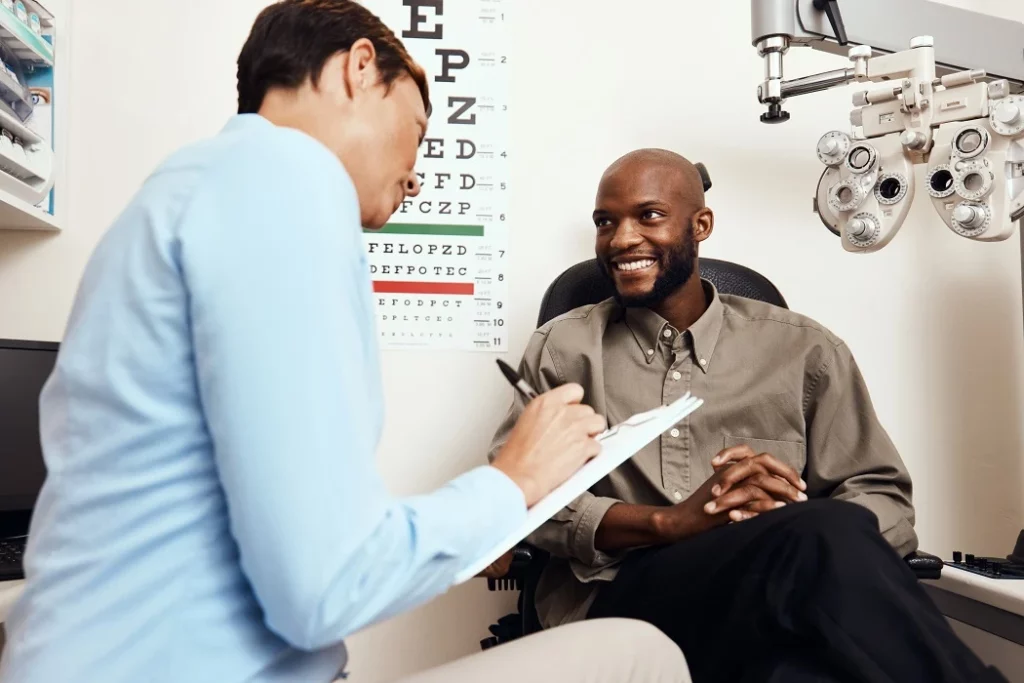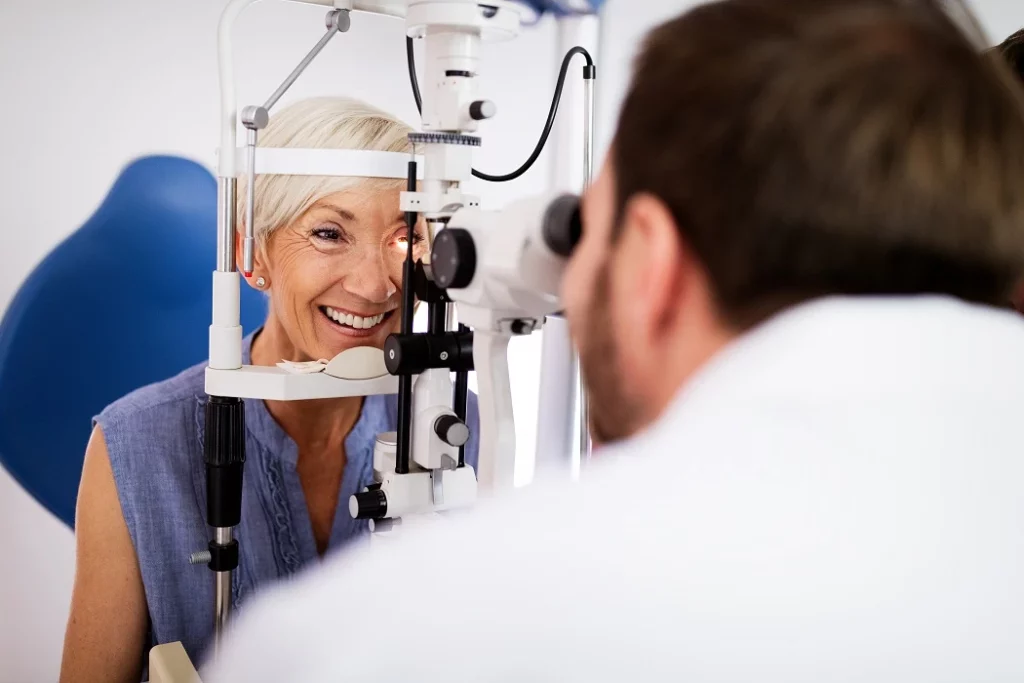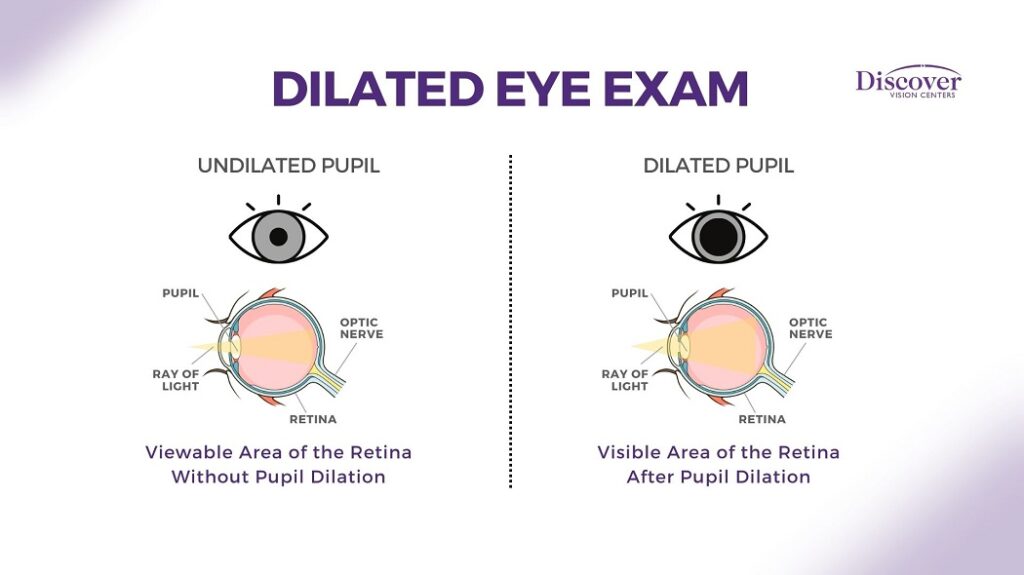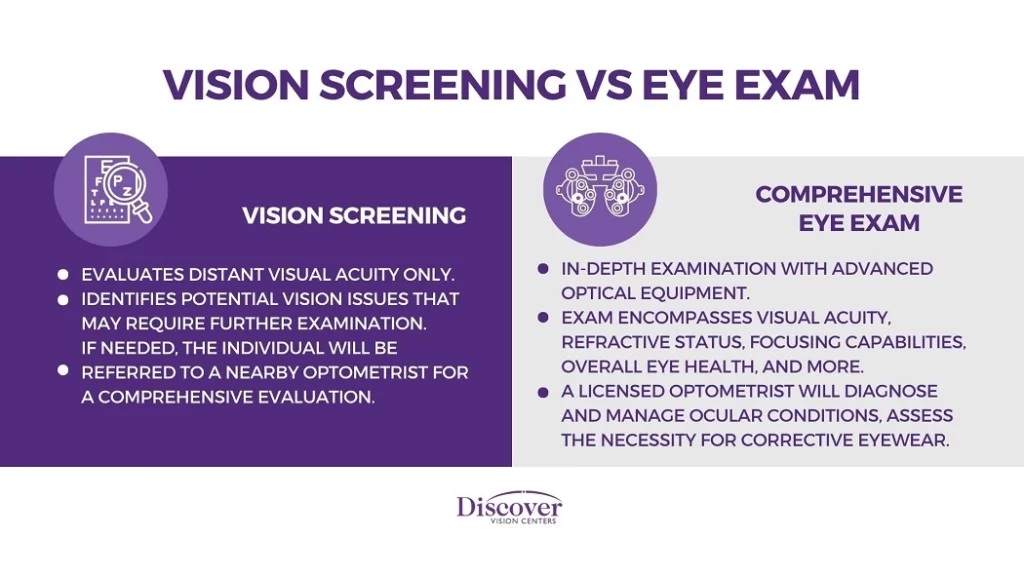
Updated: December 14, 2023
Your eyes are the gateway to the world around you, guiding you through life’s experiences. Whether you’re admiring a breathtaking sunset or tackling your daily routines, your vision is an invaluable asset. This highlights the significance of regular visits to the eye doctor. At Discover Vision Centers, we prioritize your eye health and offer routine eye exams to keep your vision as sharp as possible.
Ever wondered about the diverse range of vision tests incorporated into a comprehensive eye examination? Let’s learn the various types of eye testing available.

An eye exam encompasses a series of vision tests used by a healthcare professional to assess the well-being of your eyes. Beyond merely determining your eyeglass or contact lens prescription, the primary focus of a comprehensive eye exam is the overall health of your eyes.
These exams are crucial in the early detection of serious vision issues like cataracts and macular degeneration. In addition to vision tests, discussions about recent vision changes are an integral part of the examination, offering you the opportunity to seek clarifications and ensure optimal vision health.
When it comes to evaluating your eye health and vision, many tests can be used. These tests are designed to assess different aspects of your eyes, ranging from visual acuity to peripheral vision. Let’s explore the details of each of these eye examinations:
The basic eye exam (“Snellen Eye Chart” test), is where you identify letters on a chart at a distance to determine the clarity of your vision.
Refraction involves the bending of light waves when they traverse your cornea and lens. This is a crucial assessment to determine if you need vision correction as well as the specific prescription for corrective lenses that’ll give you the most clarity and sharpness in your vision.
During this examination, your eye doctor may employ a phoropter, a specialized device designed to aid in identifying your refractive error. This assessment typically occurs in a dimly lit room, enhancing your ability to perceive images through the phoropter’s lenses more clearly. This process is repeated several times to pinpoint the precise lenses that can provide you with the optimal lens prescription for your best visual acuity.
This examination checks your peripheral vision by prompting you to identify objects or lights that appear in your field of vision.
Utilizing a microscope with intense light, this test allows for detailed examination of the cornea, iris, lens, and anterior chamber, often aided by fluorescein dye to detect irregularities.

A vital test that measures intraocular pressure to detect developing glaucoma, a potentially vision-threatening condition. Non-contact tonometry is a common method used.
This test assesses your ability to distinguish colors by identifying numbers or letters within multicolored circles.
During this examination, you’ll focus on an object while your eye care provider uses a phoropter and shines light into your eyes. This helps determine the need for vision correction.
Thousands of images of your cornea are taken to map its shape, aiding in the assessment of conditions like astigmatism and suitability for procedures like corneal transplant.
After dilating your pupils with eye drops, this test involves shining a light into your eye to examine the retina, optic nerve, and blood vessels at the back of your eye.
| Age Group | Asymptomatic/Low Risk | At-Risk |
|---|---|---|
| Birth – 2 years | 6-12 months | 6-12 months or as recommended |
| Ages 3-5 | At least once between 3-5 years | At least once between 3-5 years or as recommended |
| Ages 6-17 | Before first grade and annually | Before first grade and annually thereafter or as recommended |
| Ages 18-39 | At least every two years | At least annually or as recommended |
| Ages 65 and older | Annually | At least annually or as recommended |
How often are eye tests needed? In reality, the frequency of eye examinations for pediatric patients depends on their risk factors. For example, children with certain risk factors may require more frequent examinations based on professional judgment. Risk factors include prematurity, family history of eye conditions, maternal health during pregnancy, and more.
Patients who have undergone refractive surgery (LASIK, PRK, SMILE) should continue to have regular eye exams every 1-2 years to monitor overall ocular health. Regular eye exams are important for maintaining eye health and detecting potential issues early.

A dilated pupillary exam goes beyond simply checking your vision; it plays a key role in safeguarding your eye health. Comprehensive eye exams serve as a means to detect a range of medical conditions, such as:
Vision screening programs are a valuable tool to detect potential vision issues in children and adults. When an eye screening suggests a problem, individuals are referred for further evaluation. However, you shouldn’t solely rely on screening as it has its limitations. It cannot replace the comprehensive insights that come from a thorough eye and vision examination.
Various entities, including schools, pediatricians, and driver’s license agencies, often conduct vision screenings as part of their services. While these screenings can uncover certain vision problems, they may miss a significant number of issues, raising concerns about their effectiveness.
Unfortunately, current vision screening programs may not be reliable in identifying those who need vision care. In some instances, eye screening can even hinder the early detection of vision problems, leading to a false sense of security for those who “pass” the screening but may have undetected issues. This causes a delay in diagnosis and treatment that can potentially worsen eye problems over time.
Undiagnosed and untreated vision issues can have far-reaching consequences, affecting a child’s educational progress, participation in sports, and an adult’s ability to work and drive safely. Timely diagnosis and intervention are critical, as they minimize the impact of eyesight problems on an individual’s quality of life.

Distinguishing between a routine eye exam and a vision screening can help you understand the depth of evaluation needed for maintaining optimal eye health and preventing vision loss.
Only qualified professionals, such as doctors of optometry or ophthalmologists, have the expertise and specialized equipment needed to conduct thorough eye and vision examinations and deliver definitive diagnoses and tailored treatment plans.
A comprehensive adult eye examination is made from various elements:
From assessing eye pressure to uncovering potential health conditions, eye exams are an easy way to safeguard your vision and overall well-being. While some tests are integral to routine eye exams, others are conducted as needed to diagnose specific issues.
At Discover Vision Centers, our expert eye care professionals use a comprehensive array of eye exams to ensure your vision is at its best. Schedule your routine eye exam today and experience the difference that thorough eye care can make in your life.